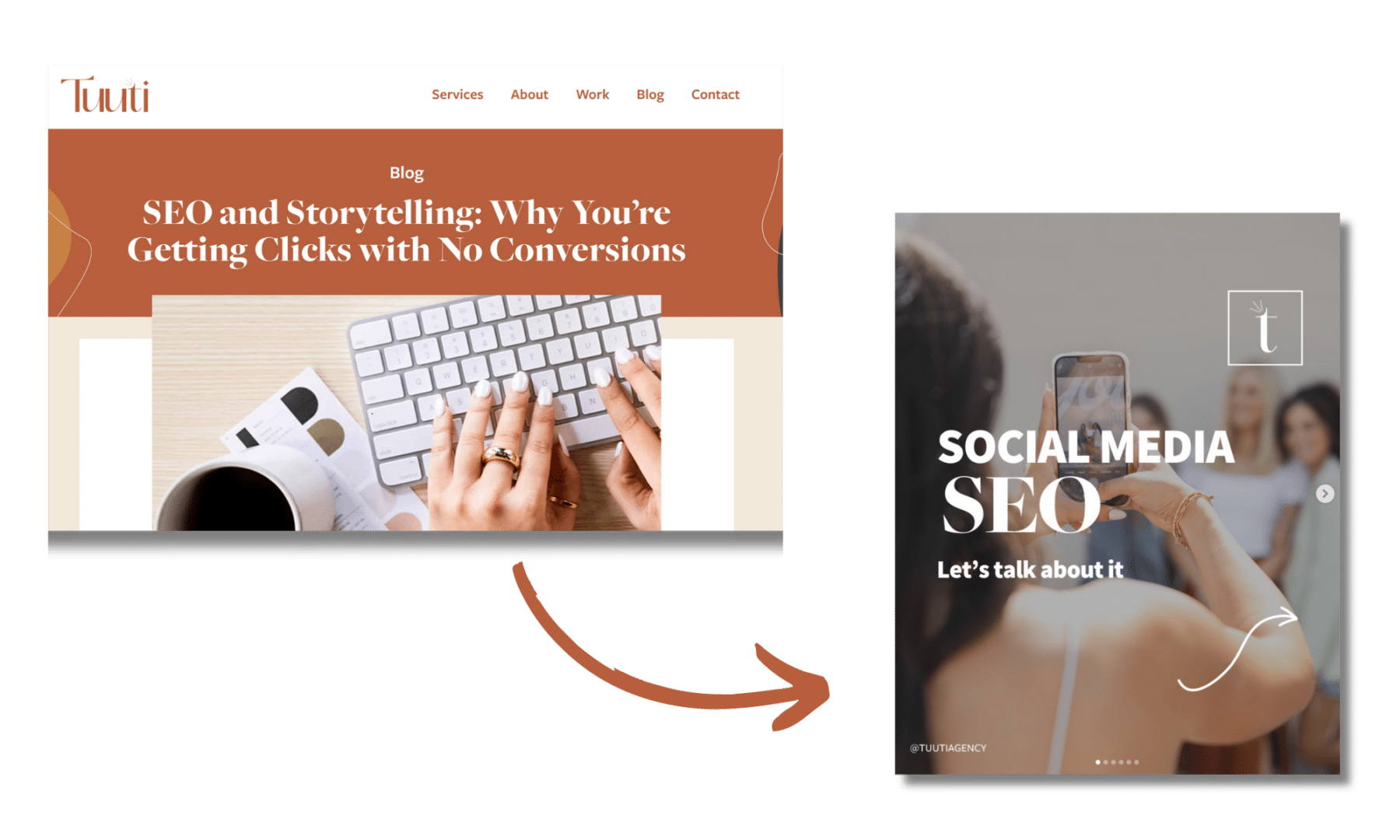Did you hear? Blogging is back and better than ever!
Blogs have been around since the very beginning of the Internet, but they have extra value in today’s digital landscape. If you want to be more than a bystander in your industry, then writing a business blog is the place to start driving conversations.
A blog has so many potential benefits for your business, including:
- Sharing education with clients and other professionals
- Increasing organic traffic to your website
- Converting readers into clients or customers
- Expanding brand awareness
- Bridging the gap between your company and your audience
- Giving you more content to share on social media
A blog can be many things and come in many forms, but typically a blog is a section on your website dedicated to posting pieces of writing related to your company. Let’s take a look at the steps to take as a business starting your very own blog.
1. Find Your Niche
If you want to start a blog, you should first consider what you have to say. There are a huge variety of blogs out there. The hard part is choosing your expertise and honing into what people will want to read. When starting a business blog, you should tailor your niche towards your industry or field. Here are some questions that can help guide your process:
- What experience do you have to share?
- What does your company specialize in?
- What are you passionate about?
You should also determine what audience you want to reach. If you’re a consulting agency, you might tailor your posts for business managers and CEOs. If you’re a retailer, you could choose to post about local events or product recommendations. You can also post interviews, new product details, or other brand-related content. Here at Tuuti, we focus on topics in branding, content marketing, PR, and social media to keep our clients and audience up-to-date on the latest trends and strategies in our field. (Much like the article you’re currently reading!)
2. Make Your Blog Page
There are several ways to host a blog, but most businesses choose to add their blogs to their existing website, which can be a new way to bring traffic into your domain. All you need to start is a landing page and a template for your blog articles. You may also consider adding categories to your website, especially if you’re planning to post about a variety of topics. Categories will help filter your content to make your site easier for readers to navigate. The Tuuti blog landing page features a menu with categories to help readers filter through content, which you can see below.
If you want to elevate your website, you can also install blog plug-ins. We use the Elementor plug-in for our blog site to make content easier to edit and design, including if you need to create a new template for your blog. To set yourself up for SEO success, Yoast SEO is what we recommend to easily add title tags, meta descriptions, and keywords. Ultimately, be sure to do your own research — there are lots of plug-ins to help you out!
When you create your blog as a business, you also want to keep your blog consistent with your branding to support a cohesive and easily recognizable brand identity. If you have a Brand Guide, such as established colors and fonts, be sure to stick with those on your blog pages. Website-building platforms like Wix and WordPress have templates you can customize to adhere to your brand guidelines. If you want to learn more about creating brand consistency, check out our guide to creating your brand identity.
3. Create a Content Calendar
A content calendar is a strategic plan for what articles will be posted when, like what you’d create to outline upcoming posts on social media. If your company is focusing on multiple projects, a content calendar is especially important to stay organized and strategic. The last thing you want is to miss out on a great opportunity for content related to a new launch or campaign! The content calendar you create for your blog can be similar to your social or PR content calendars. The more synchronized you are between channels, the more success you tend to have as a whole. Blogs can feed ideas for social media posts, or vice versa.
During this planning phase, you should also consider how long you want your blogs to be and how often you want to post. Blogs can be any length and posted at any frequency, but the key here is consistency. A content calendar helps keep your posting consistent, which enhances engagement and SEO performance. Our recommendation is typically 2 to 4 blog articles per month since websites that post new content regularly are prioritized in search engine results. Then, once you have a calendar organized and set, it’s time to start thinking about your first blog post!
4. Brainstorm
Figuring out what to write about is sometimes the most difficult part of this process. If you’ve already determined your niche, it will be much easier to narrow down ideas. I recommend creating a document to list out all your ideas, which you can keep adding to as you go along. Here’s a few ways to generate writing topics:
- Read other blogs or articles. Try researching what other experts in your field or your competitors are saying. It’s helpful to see different experiences and perspectives before working on your own blog.
- Ask AI. Using AI as a brainstorming tool is actually the best way to use AI as a writer. AI can pull from a variety of sources in only seconds to give you a long list of hot topics that you can make your own. AI can also provide guiding questions to consider to kickstart your writing process.
- Pay attention to what makes you most excited. If your curiosity leads you in a certain direction, follow it! You never know where your questions will lead you, but with some luck, you can find a blog topic that will spark curiosity in yourself and in your readers.
EXPERT TIP: If you want to generate bigger, better ideas to help inform your business blog posts and your content strategy, create a cohesive marketing campaign!
Once you have a long list of ideas, it can be so difficult to decide what to do first. My recommendation is to start more generally with your pillars, or biggest areas of expertise. Then from there, you can branch out into more specific cluster topics based on those pillars. You may hear this referred to as the pillar-cluster model, and it works wonders for organizing your content and supporting SEO efforts. Speaking of SEO…
5. Add SEO to Your Content
Once you have a topic selected for your article, you can work on search engine optimization (SEO). Adding SEO to your content is huge — it helps your company show up in organic traffic and bring more people to your site!
Using a site like SEMrush, you can start your SEO keyword research by generating keywords to use in your blog. Then, you can use those keywords to outline your main points. Consider guiding questions like “what would someone searching want to learn from a post like this?” or “what are the most important aspects of this topic?”
You can also use Google to search for similar blog articles and pinpoint what keywords are popping up most frequently. From there, you can play with those terms to see if different words render different results in your SEO tool. Sometimes, there will be related keywords that are much easier to rank for in Google. When you have a collection of keywords to work with, you can start incorporating them into your blog article. As you write and edit your post, you can insert keywords in the text, subheadings, title tags, and meta descriptions.
Keep in mind that SEO is an ongoing process. Search engine optimization is not a one-time thing. Once an article is live, you should track its success in Google Analytics and Google Search Console. From these, you can get ideas on what keywords are gaining traction for you. Then in your published articles you can update your keywords, title tags, and meta descriptions as needed to optimize the content. Even after you press publish on a blog post, you can continue to research SEO keywords to boost your chances of getting seen.
6. Write and Publish Your First Blog Post
Now it’s finally time to write! The first step to this process usually involves building an outline to help define the main points of your blog post. This is where you can decide on the organization of your blog post, or what order you want your ideas to flow in. You can use a traditional essay form (with an introduction, body paragraphs, and conclusion) for blog posts, but there are lots of different ways to write an article. There are listicles, how-to guides, and narrative styles that may work better for some blog ideas. Don’t be afraid to switch it up and try a new format once you’re in a blog-writing rhythm!
After completing an outline, you can start writing paragraphs around your main points. Feel free to start wherever you need to. Your piece doesn’t have to be written in order, or in one sitting. First drafts are often messy, and that’s okay! Getting the words down is the most important part. Just like everything, practice makes perfect! You will get better and better at blog writing as you go along, so don’t be discouraged if you don’t like what you have at first. Also, you can (and should!) always come back to edit and proofread your content after you have your initial draft.
When you’re finished writing and editing your first blog post, it’s time for the finishing touches. A featured image photo is a must, but adding imagery and videos in your article itself can improve your Google ranking. You can find images to use in the article from your company databases, or stock photos from various sites like iStock and Getty Images.
EXPERT TIP: Photoshoots in-house can elevate your brand with custom images to use on your blog, social media, and website. Sometimes if you want to stand out, the difference can be the images you use!
7. Promote Your Blog
If you want your blog to gain traction, the simple answer is to promote it. Often, the issue is your audience doesn’t even know your blog exists to give them education or tips.
One place to start is by creating a business blog newsletter. A newsletter platform like MailChimp or Constant Contact can help you get your blog out into the world through emails. Many successful blogs have newsletter sign-ups on their website so people organically sign up to receive news. Consistency can also translate to brand loyalty. If your customers are used to seeing your name in their inbox or feeds a few times a month, and even look forward to it, your content gets more attention.
You might also choose to promote your business blog on social media platforms like Instagram, Facebook, or LinkedIn. You can repurpose and post your own content on your social channels, like in our example below. Or, you can ask others to repost your content to reach a wider audience. And just as you can use SEO keywords as part of your content strategy when writing posts, you can also add SEO keywords to social posts! More and more, social media is the new search engine, especially for younger consumers. Not only does this help your social presence, but it also gets more clicks to your website.

Another way to market your blog is to connect with other bloggers or readers in your community by reading, following, and commenting on other blogs. For example, you can try blogging on a social channel like Medium or Substack. A supportive network of collaborators, writers, and like-minded professionals can make a huge difference in who sees your content. Substack also has a free newsletter feature that automatically sends your subscribers emails to notify them of your new post; email marketing doesn’t get easier than that!
Final Thoughts
There you have it — all the steps to create your own business blog! Blogging can help your company generate more organic traffic, digital awareness, and revenue. Blogs may take time and energy to create, but it can also be so rewarding as a brand! With a good strategy, some curiosity, and a drive to create, a blog can separate you from the rest of the pack. Because now, more than ever, making your mark as a brand matters.
Want to get started on a blog for your business but want some support? We’d love to help — reach out to our team today!







